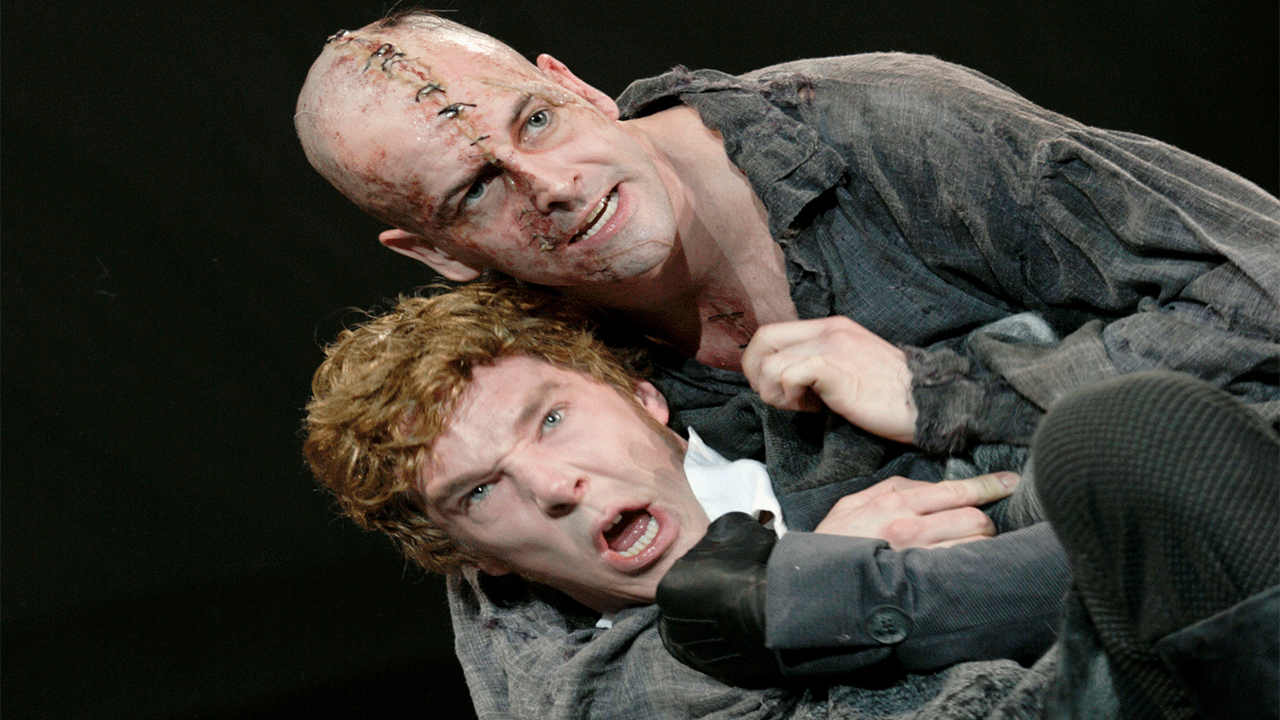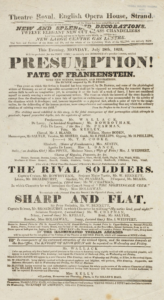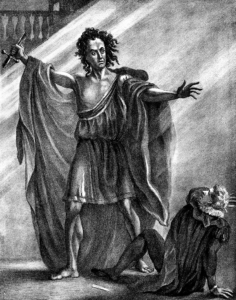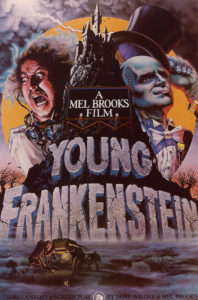

Playbill for Peake’s Presumption (1823)
In 1823, an apprentice engraver turned dramatist, Richard Brinsley Peake, suddenly became the celebrated author of a new melodrama entitled Presumption; or The Fate of Frankenstein. Much controversy revolved around the play’s violent, possibly blasphemous subject matter, which Gentleman’s Magazine termed “replete with too many horrors.” But the work was also decried because of the parentage of the female novelist whose book inspired Peake’s adaptation. Mary Godwin (later Shelley) was the offspring of the late eighteenth century’s most notorious power couple: free-thinking philosopher/novelist William Godwin, author of Enquiry Concerning Political Justice, and Mary Wollstonecraft, whose A Vindication of the Rights of Woman launched modern feminism. To make matters worse, young Mary Godwin was pregnant and living out of wedlock in Switzerland with Percy Bysshe Shelley, the young poet who had been expelled from Oxford University for publishing a pamphlet provocatively entitled The Necessity of Atheism. Percy Shelley and Mary Godwin had eloped to Switzerland, where they met up with an even more famous reprobate, the notorious Lord Byron. It was there, beside Lake Geneva, where Mary—just eighteen years old!— composed her terrifying novel about a man of science who dared to create human life from dead body parts, contravening the laws of God and Christian morality. As The Morning Post observed of Presumption, “To Lord Byron, the late Mr. Shelley, and philosophers of that stamp, it might appear a very fine thing to attack the Christian faith…and burlesque the resurrection of the dead…,” while Theatrical John Bull noted Peake’s adaptation was “taken from a Novel, by a woman who…is one of the coterie of that self-acknowledged Atheist, Percy B. Shelley, and the daughter too of the well-known Godwin—a precious breed and association.”
Such was the enthusiasm inspired by Peake’s melodrama that by the mid-1820s more than a dozen different versions of Shelley’s novel had appeared on stages in England, France, and the United States.
Observing the budding controversy surrounding his daughter’s novel, William Godwin saw not scandal but a marketing opportunity, and wrote his daughter about the adaptation:
“I know not whether it will succeed. If it does, it will be some sort of feather in the cap of the author of the novel, a recommendation in your future negotiacions [sic] with booksellers.” After attending a performance at the Lyceum Theatre on August 23, 1823, Mary also offered qualified approval: “The story is not well managed—but Cooke [the actor] played —-’s [the creature’s] part extremely well…I was much amused, & it appeared to excite a breathless eagerness in the audience.”1
Indeed, such was the enthusiasm inspired by Peake’s melodrama that by the mid-1820s more than a dozen different versions of Shelley’s novel had appeared on stages in England, France, and the United States.2

Thomas Cooke as the monster in R.B. Peake’s Presumption: or The Fate of Frankenstein (1823)
For Mary Shelley, a first-time novelist whose work had been anonymously printed in an edition of just 500 copies, this international explosion must have seemed amazing. Frankenstein’s sudden hold on the contemporary imagination may be attributed to its appearance at the nexus of late-Enlightenment discovery (a time when theories of evolution were being hotly debated), and the excitement surrounding the Romantic movement in the arts. Together with the late-eighteenth-century interest in the Gothic and Romanticism’s exaltation of the properties of the human imagination and the Sublime, a revolution in the arts was sweeping across Europe and England. All these elements are central to Frankenstein, with its Faustian exploration of the limits of scientific enquiry, and its Promethean defiance of divine order. Subtitled, “The Modern Prometheus,” Frankenstein exquisitely captured the defiant Zeitgeist of the Romantic Age in its combination of all of these elements, both scientific and literary.
But Frankenstein’s brilliant engagement with the Romantic Weltanschauung does not explain why the myth should still speak so powerfully to us today. In 2011, playwright Nick Dear’s stage adaptation of Frankenstein opened at the Royal National Theatre in London with two celebrated actors, Benedict Cumberbatch and Jonny Lee Miller, alternating nightly in the central roles of Dr. Frankenstein and his nameless creature. Although this recent version is but one of scores of film and stage adaptations that have seized the public’s imagination over the past half-century or so, Dear’s adaptation is surely one of the most successful, popular, and aesthetically satisfying. Directed by the Oscar-winning film and stage director Danny Boyle, this version of Frankenstein was internationally broadcast worldwide via satellite in more than three hundred cinemas, arguably offering a level of public exposure analogous to Peake’s in 1823. Comparing these two very distinct stage versions may help us understand the Frankenstein legend’s still formidable command on our collective imagination today.
One of the most noteworthy accretions is the character of Fritz, Frankenstein’s bumbling laboratory assistant, a comic figure who appears in so many film versions of the story that the reader returning to the novel after an extended period may almost feel shocked to find him missing from the original.
It seems self-evident that the legacy and importance of the Frankenstein myth impacts us differently than it affected audiences in the nineteenth century. No longer do we see the story simply as a metaphor of scientific hubris or religious impiety. Today, Frankenstein is ubiquitous in our popular culture—in everything from Frankenberry, a sugary, fruit-flavored cereal, to a cornucopia of pesticide-laden and lab-engineered edibles known as “Frankenfoods.” The famous monster is present in the endless rows of masks with the visage of Boris Karloff at Halloween, to the latest satirical cartoon of a zipper-faced, bolted Donald Trump as a manifestation of his takeover of the Republican Party. The novel’s startling depiction of the Arctic is alluded to at scientific conferences on global warming; the creature’s forlorn visage is evoked in discussions of Otherness and Black Lives Matter. The creature is with us at campy screenings of The Rocky Horror Picture Show, Andy Warhol’s Flesh for Frankenstein, or affectionate parodies like Mel Brooks’ Young Frankenstein. Since the monster’s rejection is due to its grotesque physiognomy, the creature is even alluded to in the new field of Disability Studies. Although contemporary allusions and references to Frankenstein are far too numerous to name, it is clear that after two hundred years both Victor Frankenstein and his creature are very much with us, leading one scholar to observe: “so deeply does [the Frankenstein legend] probe the collective cultural psyche of the modern era that it deserves to be called a myth, on a par with the most telling stories of Greek and Norse gods and goddesses.”3

Poster for Nick Dear’s Frankenstein (2011)
Peake’s Presumption was not conceived as a mythic representation, or even as a faithful literary treatment of Mary Shelley’s novel. Rather, it was intended to exploit the public’s fascination with the Gothic and the grotesque, something novelist William Beckford intuited at the time when he scrawled the following on the flyleaf of his own copy of the novel, calling it “the foulest Toadstool that has yet sprung up from the reeking dunghill of present times.”
The title Presumption clearly indicated the work’s attempt to distance itself from Frankenstein’s impious aspirations, even as the play exploited an eager public’s curiosity about those same transgressions. One playbill essay sought to remind its audience that “[t]he striking moral exhibited in this story, is the fatal consequence of that presumption which attempts to penetrate, beyond prescribed depths, into the mysteries of nature.” At the same time, the producers hoped to reap the benefits of the work’s spectacular effects and horrifying monster. Sure enough, the guardians of public morality took the bait, peppering the streets with handbills intended to upbraid the proprietors of the theatre for their inadequate attention to “Moral and Religious Conduct”:
Do not go to the Lyceum to see the monstrous Drama, founded on the improper work called “Frankenstein.” –Do not take your wives or families—The novel itself is of a decidedly immoral tendency; it treats of a subject which in nature cannot occur. This subject is pregnant with mischief; and to prevent the ill-consequences which may result from the promulgation of such dangerous doctrines, a few zealous friends of morality… are using their strongest endeavors. Then, as now, such attacks only served to whip up the appetite of the theatergoing public, leading one publication to sarcastically observe: “You have only to tell a Cockney that an Exhibition is shocking—abominable—impious, and off he starts to bear witness to the fact, without even staying to wash his face.”4
In spite of the controversy surrounding the play, the script of Presumption is a conventional melodrama of the period. It is filled with music and songs, even a corps de ballet of dancing peasants for the anticipated wedding scene in the mountains. The play is also suitably theatrical. It includes fire, gunshots, and storms. It presents dramatic spectacles such as the burning of the De Lacey cottage and a climactic avalanche precipitated by Frankenstein’s own pistol shot which buries both monster and creator at the conclusion of the play. The plot of Presumption was streamlined and made linear for the purposes of stage production, and among the cuts was the elimination of the Walton subplot, a choice that has been followed in almost all subsequent adaptations, both theatrical and cinematic. Family relationships are also significantly altered. Elizabeth Lavenza was recast as Frankenstein’s sister, rather than his cousin and fiancé, presumably sidestepping the incestuous implications in the novel. In Peake’s version, Elizabeth is engaged to Frankenstein’s friend, Henry Clerval, while Frankenstein is affianced to Agatha. One of the most noteworthy accretions is the character of Fritz, Frankenstein’s bumbling laboratory assistant, a comic figure who appears in so many film versions of the story that the reader returning to the novel after an extended period may almost feel shocked to find him missing from the original.
There is one important respect in which Presumption remains faithful to the core of Shelley’s novel—its intuitive grasp of the symbiosis between the creator and his creature.
Although the reader of Peake’s adaptation is likely to dismiss it as an insignificant piece of early nineteenth-century froth, there is one important respect in which Presumption remains faithful to the core of Shelley’s novel—its intuitive grasp of the symbiosis between the creator and his creature. In the novel, it is apparent that Victor Frankenstein acts rashly and irresponsibly in abandoning his creation at the very moment of its birth: “How can I describe my emotions at this catastrophe, or how delineate the wretch whom with such infinite pains and care I had endeavored to form?” Frankenstein proceeds to describe his transition from joy to horror at seeing the magnificent child of his imagination transformed into something hideous:
His limbs were in proportion, and I had selected his features as beautiful. Beautiful!—Great God! His yellow skin scarcely covered the work of muscles and arteries beneath; his hair was of a lustrous black, and flowing; his teeth of a pearly whiteness; but these luxuriances only formed a more horrid contrast with his watery eyes, that seemed almost of the same colour as the dun white sockets in which they were set, his shriveled complexion, and straight black lips.5
In Presumption, Peake chooses to retain Shelley’s text almost verbatim:
I had selected his features as beautiful—beautiful! Ah, horror! his cadaverous skin scarcely covers the work of muscles and arteries beneath, his hair lustrous, black and flowing…but these luxuriances only form more horrible contrasts with the deformities of the monster. What have I accomplished? The beauty of my dream has vanished!
As a result, the adaptation maintains considerable sympathy towards the Monster, and the creature’s initial appearance in Peake’s play offers a remarkable tableau vivant in which creator and creature stare silently at one another for a moment, followed by “gestures of conciliation” as the child-monster seeks to mollify his horrified parent.

Trumpenstein (circa 2016)
Peake’s understanding of the creature’s essential innocence comports precisely with the novel. He is Rousseau’s natural man reborn—and each moment of his existence echoes the newborn’s sensitivity to light and air. The creature mistakenly thrusts his hand into the gypsies’ fire before discovering the pleasures of roasted rather than raw food. Similarly, in old De Lacey’s cottage, the creature discovers the pleasures of music and gleefully helps collect firewood for his blind master. Part infant, part man, the creature “smiles with gratulation at [all] that he has accomplished],” and upon approaching De Lacey, “falls flat at his feet, then kneels to him, and is about to press his hand.”6
Although he abducts William and Agatha in Peake’s version, his destructive energy is seen as the direct result of ill-treatment by his master. In this respect, Peake’s monster echoes Mary Shelley’s own creature when he confronts his maker on Mont Blanc:
How dare you sport with life? Do your duty towards me, and I will do mine towards you and the rest of mankind…Have I not suffered enough, that you seek to increase my misery? … I am thy creature, and I will be even mild and docile to my natural lord and king, if thou wilt perform thy part, which thou owest me.7
The conclusion of the play is faithful to this central conflict. And while the snowy avalanche is not present in the novel, the act of mutual destruction initiated by Dr. Frankenstein’s two pistol shots, the emblem of their twinned fates, feels like an appropriate (if melodramatic) conclusion.
Nick Dear’s 2011 adaptation of the novel for the Royal National Theatre of Great Britain is a theatrical Frankenstein for the twenty-first century. Eschewing the spectacular effects so deeply embedded in both theatrical and cinematic traditions (especially the latter, where an elaborate opening image of Dr. Frankenstein’s laboratory has been cinematically de rigeur), the play opens in complete darkness with the only sound that of a beating heart. After a brilliant flash of light, the audience is returned to darkness and the sound of “Boom-Boom” once again. This sequence is repeated until the audience finally comprehends—we are witnessing the creature’s birth not from the traditional perspective of the brilliant scientist feverishly bestowing life on inanimate matter, or the hysterical shout of “It’s alive!” but rather from the creature’s own perspective. This is not mere sleight-of-hand theatricality. Rather, this single choice transforms the story from a tale about scientific presumption into an interior drama seen through the perceptions of the unhappy creature. By so doing, Dear has freshly minted Shelley’s story for our times as a tale of isolation and lost innocence. By doing what the theatre always does best—relying on the audience to use its collective imagination—the play forces us to participate actively in the process of the creature’s miraculous birth.
Dear’s play opens in complete darkness with the only sound that of a beating heart. … we are witnessing the creature’s birth not from the traditional perspective of the brilliant scientist feverishly bestowing life on inanimate matter, or the hysterical shout of “It’s alive!” but rather from the creature’s own perspective.
Obliging us to see the event through the eyes of the newborn rather than from the perspective of the scientist, Dear’s adaptation powerfully uncovers the theatrical equivalent of the opening of Volume II of the novel where the creature reminds his maker of his original innocence, akin to that of Milton’s Satan: “Remember, I am thy creature: I ought to be thy Adam; but I am rather thy fallen angel, whom thou drivest from joy for no misdeed.”8 Following its birth, the play’s opening scenes chart the stages of a child’s development. We see it crawl, walk, bang on a kettle like a toy drum, and discover joy in the sun’s warmth or the song of birds. As the play’s stage directions reveal, the creature is “Adam in the Garden of Eden—an innocent.” Contrary to our expectations, Victor Frankenstein is not revealed until the play’s third scene, and then we see him “repulsed by the slimy being sprawled out in front of him.” The novel’s central metaphor of an innocent child deliberately abandoned by its parent could not be more clearly or effectively translated for the stage.
The Victor Frankenstein of Dear’s adaptation is depicted less as a romantic titan like Goethe’s Faust, who aspires to exceed his mortal limitations, and more as that trope of our own times, the emotionally empty man of science, someone incapable of either compassion or empathy; “You were an equation. A theorem. I confess it. A problem to be solved,” he admits. Frankenstein’s first action in the play is to counter the creature’s frantic attempt at an embrace by throwing his cloak over the head of his creation and running away. Later in the play, when Elizabeth aggressively kisses Victor, hoping to persuade him to give her a child, the scientist again trumps the human being. “Have you any interest in me?” she asks, while Victor’s response feels both robotic and evasive: “You are beautiful. You will make a beautiful wife.”9

Mel Brooks’s Young Frankenstein (1974)
Bereft of his parent as he is in Shelley’s novel, the creature is forced to make his way in the world alone. And this estrangement from both his maker and parent may provide a clue to what speaks so powerfully to us today. From De Lacey, he learns to speak, read, and appreciate music, but the blind old man’s generosity and compassion are contradicted by the reality that human beings only see him as deformed and hideous. Whipped by the cottagers he sought to befriend, the outcast who first took pleasure in the civilized act of bundling kindling as a gift now becomes a murderer who burns the De Laceys alive in their cottage.
Dear has freshly minted Shelley’s story for our times as a tale of isolation and lost innocence. By doing what the theatre always does best—relying on the audience to use its collective imagination—the play forces us to participate actively in the process of the creature’s miraculous birth.
As in the novel, the creature devolves from pure innocence into a demon; he is Milton’s Adam become his Satan. “I, like the arch fiend, bore a hell within me,” he cries. “I declared everlasting war against the species, and more than all, against him who had formed me, and sent me forth to this insupportable misery.”10 The creature’s transformation into a monster culminates in a particularly gruesome scene in Dear’s adaptation. Promised a bride to balm his loneliness, he dreams of what is to come: “I’ll clothe her in lace and velvet. I’ll give her silks and pearls.”11 But the monster instead must watch while the scientist sadistically hacks his mate to pieces, extinguishing his last hope for relief from loneliness. Whereas in Shelley’s novel, this act of savage mutilation is undertaken in isolation in the Orkney Islands, and is intended to demonstrate Victor’s decision not to unleash another monster upon the world, in Dear’s adaptation there is no such deliberation, and the creature’s last hope for companionship is destroyed before his very eyes.
This act of inhumanity leads to a dramatic event which represents a radical—and daring—departure from the climactic scene in Shelley’s novel. Having heard the creature swear to “be with you on your wedding night,” the novel’s Frankenstein mistakenly assumes his adversary wants to kill him, not his bride, and so he leaves Elizabeth alone and unprotected. In Dear’s adaptation, however, the monster comes to her just prior to her marriage, and we witness a very real bond develop between the creature and Victor’s bride, illuminating the Stage Direction that “the Creature may be more capable of love than Victor is.” However, the monster has been steeped in the deceitful ways of his master, and despite his promise to do her no harm, he rapes and murders her on her bed. Perhaps even more disturbing than this act is Victor’s response. Bursting in the door and seeing his creation mounting Elizabeth, he “hangs back in appalled fascination as he watches his Creature mating.”12 Even at this horrific moment, Frankenstein’s observational instincts take precedence over his feelings as a human being.
As Nick Dear’s adaptation powerfully reminds us, in the twenty-first century the tale’s true hero is unequivocally the monster. Nameless and disenfranchised, his presence conveys the essence of the novel’s power, reminding us of what it means to be both human—and Other—in an increasingly alienated and dehumanized world in which love and nurture seem to have vanished.
From this scene onward, Victor and the creature essentially change places, just as in the novel, with the master desperately trying to wreak vengeance on his abandoned creation. In the novel, the monster articulates this role reversal plainly: “Slave, …Remember that I have power; you believe yourself miserable, but I can make you so wretched that the light of day will be hateful to you. You are my creator, but I am your master;—obey!” In both the novel and Dear’s adaptation, the two are indissolubly imprisoned in a living hell that concludes with Frankenstein’s death on Walton’s ship and the monster’s announcement that “I shall seek the most northern extremity of the globe; I shall collect my funeral pile, and consume to ashes this miserable frame.” He is finally “borne away by the waves, and lost in darkness and distance.”13
Dear’s adaptation creates an analogous mood, with the monster grotesquely taunting and humiliating his human prey. It is now the scientist who is revealed as sub-human:
Victor: Every chance I had of love, I threw away. Every shred of human warmth, I cut to pieces. Hatred is what I understand. Only you give me purpose. You, I desire. Go on. Walk on. You must be destroyed!
Creature: Good boy. That’s the spirit! Bring my miserable line to an end! Up! Up!
However, in contrast to the novel where there is at least a kind of resolution in the deaths of Victor and, supposedly, his creation, Dear’s play concludes with an even more disturbing, unresolved image of torment with “the Creature prancing in front of Victor, who struggles after him.”14
After two hundred years, Mary Shelley’s Frankenstein lives on, constantly amazing us with its currency and power, taking on new and surprising forms, moving us as few other works of nineteenth-century fiction can. Its Byronic anti-hero, Victor Frankenstein, once projected an aura of resolve and ambition comparable to that of Prometheus or Faust. However, in our technically advanced, digital age it is not the flawed man of science who commands our sympathy or respect. As Nick Dear’s adaptation powerfully reminds us, in the twenty-first century the tale’s true hero is unequivocally the monster. Nameless and disenfranchised, his presence conveys the essence of the novel’s power, reminding us of what it means to be both human—and Other—in an increasingly alienated and dehumanized world in which love and nurture seem to have vanished. Reminding us of the creature’s essential innocence, his loneliness and inability to find either parent or mate, this new re-visioning leads us back to the mythic power of the original novel, a work which chronicles what it means to be alone in a world constructed around and dominated by scientific progress—and little else.
